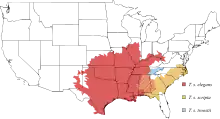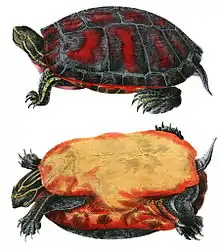Cumberland slider
The Cumberland slider (Trachemys scripta troostii), also called commonly the Cumberland turtle and Troost's turtle, is a subspecies of pond slider, a semiaquatic turtle in the family Emydidae. The subspecies is indigenous to the Southeastern United States.
| Cumberland slider | |
|---|---|
 | |
| Trachemys scripta troostii, hatchling | |
| Scientific classification | |
| Domain: | Eukaryota |
| Kingdom: | Animalia |
| Phylum: | Chordata |
| Class: | Reptilia |
| Order: | Testudines |
| Suborder: | Cryptodira |
| Superfamily: | Testudinoidea |
| Family: | Emydidae |
| Genus: | Trachemys |
| Species: | |
| Subspecies: | T. s. troostii |
| Trinomial name | |
| Trachemys scripta troostii (Holbrook, 1836) | |
 | |
| Range map of the three subspecies of pond slider. The Cumberland slider is shown in blue. | |
| Synonyms[2] | |
| |
Etymology
The subspecific name, troostii, is in honor of Dutch-American naturalist Gerard Troost.[3]
Taxonomy
T. s. troostii, a subspecies of T. scripta, was formerly placed in the genus Pseudemys. The Cumberland slider occurs in a different geographic location from the yellow-bellied slider (T. s. scripta). Intergradation does not occur between these two subspecies.
Description
The carapace of T. s. troostii is olive brown with yellow markings. It has two rounded projections on the posterior edge of the shell, and is slightly keeled. The adult carapace is wrinkled and oval shaped. The plastron is hingeless and slightly smaller than the carapace. Each of the bottom sides of the marginals has a spot. The skin is brown with an olive to greenish tint with yellow striping. There is a distinct bar behind the eyes that can vary from yellow to red and be either thin or wide. The plastron of the turtle has dark spots, as well as the ridge of the carapace. Also, the plastron has bars or stripes of yellow. The turtle's legs in front have larger yellow stripes than most slider species. There is a yellow and orange stripe directly behind each eye. The stripe is never entirely one color, it starts out yellow and then fades into a dark orange-to-red color closer to the back of the neck.
Behavior
T. s. troostii is a communal basker. It basks on protrusions out of the water and may bask in stacks or with other species. It is active from April to October. "Slider" comes from its habit of sliding into the water when alarmed while basking, going to deep water for safety, where most predators cannot pursue it.
Geographic range and habitat
T. s. troostii is found throughout the Mississippi and Tennessee River drainages, and the Southeastern United States. This subspecies prefers quiet waters with muddy bottoms. Ponds, lakes, and streams, with a profusion of aquatic vegetation, organic substrate, and overhanging basking spots, are especially favored.
Most people agree that the native lands of the Cumberland slider are in the Cumberland River Valley, ranging in Kentucky and Tennessee, but with the exotic animal trade, it has become a common sight even into Alabama, Georgia, and Illinois.[4]
Reproduction
Breeding of T. s. troostii takes place in spring, fall, and winter. The male and female go through a mating ritual in which the male "claws" at the female's face and his fore legs stiffen. The female then allows the male to mount. The females may go extremely far from the water to nest and are occasionally hit by cars while crossing roads. Females construct a nest, usually at night, in various soil types. Clutch size is six to 15 eggs with 71% of the females producing two clutches per year.
Diet
T. s. troostii is mostly herbivorous as an adult, but primarily carnivorous as a juvenile.[5] The adults eat algae, fish, tadpoles, crayfish, seeds, plants, aquatic vegetation, insects, worms, and mollusks. This subspecies, like all aquatic turtles, can only swallow food when in the water.
References
- NatureServe (5 May 2023). "Trachemys scripta troostii". NatureServe Network Biodiversity Location Data accessed through NatureServe Explorer. Arlington, Virginia: NatureServe. Retrieved 21 May 2023.
- Fritz, Uwe; Havaš, Peter (2007). "Checklist of Chelonians of the World" (PDF). Vertebrate Zoology. 57 (2): 208. Archived from the original (PDF) on 2011-05-01. Retrieved 29 May 2012.
- Beolens, Bo; Watkins, Michael; Grayson, Michael (2011). The Eponym Dictionary of Reptiles. Baltimore: Johns Hopkins University Press. xiii + 296 pp. ISBN 978-1-4214-0135-5. (Trachemys scripta troostii, p. 268).
- "Cumberland Slider (Troosts Turtle)". Archived from the original on 2008-10-27. Retrieved 2009-06-26.
- Clark DB, Gibbons JW (1969). "Dietary Shift in the Turtle Pseudemys scripta (Schoeppf) from Youth to Maturity". Copeia 1969 (4): 704-706.
Further reading
- Boulenger GA (1889). Catalogue of the Chelonians, Rhynchocephalians, and Crocodiles in the British Museum (Natural History). New Edition. London: Trustees of the British Museum (Natural History). (Taylor and Francis, printers). x + 311 pp. + Plates I-VI. (Chrysemys troostii, p. 76).
- Conant R (1975). A Field Guide to Reptiles and Amphibians of Eastern and Central North America, Second Edition. Boston: Houghton Mifflin Company. xviii + 429 pp. + Plates 1-48. ISBN 0-395-19979-4 (hardcover), ISBN 0-395-19977-8 (paperback). (Chrysemys scripta troosti, p. 63 + Map 25).
- Holbrook JE (1836). North American Herpetology; or, A Description of the Reptiles Inhabiting the United States. Vol. I. Philadelphia: J. Dobson. 120 pp. + Plates I-XXIII. (Emys troostii, new species, pp. 55–58 + Plate IV).
- Powell R, Conant R, Collins JT (2016). Peterson Guide to Reptiles and Amphibians of Eastern and Central North America, Fourth Edition. Boston and New York: Houghton Mifflin Harcourt. xiv + 494 pp., 47 color plates, 207 figures. ISBN 978-0-544-12997-9. (Trachemys scripta troostii, pp. 218–219).
- Smith HM, Brodie ED Jr (1982). Reptiles of North America: A Guide to Field Identification. New York: Golden Press. 240 pp. ISBN 0-307-13666-3. (Pseudemys scripta troosti, p. 56).
- Stejneger L, Barbour T (1917). A Check List of North American Amphibians and Reptiles. Cambridge, Massachusetts: Harvard University Press. 125 pp. (Pseudemys troostii, p. 120).

